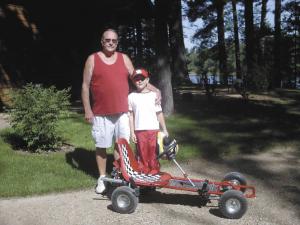Homemade Go-Cart
 ✖  |
My dad, Frank Kocina from Glencoe, Minn., built this go cart for my son Evan. We live on a lake in northern Minnesota and have a really steep driveway, so dad decided to build him a go cart that he could pull up the driveway. The go cart has an eye hook on front so it can also be towed by an ATV.
He started with a two-wheeled cart that he bought at a local farm store. He laid it down and cut off the handles. Then he built the front axle and added a riding mower steering wheel and a salvaged boat seat. He bought two additional tires for the front wheels. The cart is steered by a cable and pulley system. It has friction brakes with rubber pads cut from the bottom of flip flops. An aluminum floor pan was used to keep the weight down. The exhaust pipes on back are from an old vacuum cleaner hose. Finally, he painted the seat for a race car look.
Dad used mostly recycled parts, keeping the cost to a minimum. The entire cost of the project was about $40. My brother John helped with the welding. (Mary Kline, Menahga, Minn.)

Click here to download page story appeared in.
Click here to read entire issue
Homemade Go-Cart FARM HOME recreation 31-1-41 My dad, Frank Kocina from Glencoe, Minn., built this go cart for my son Evan. We live on a lake in northern Minnesota and have a really steep driveway, so dad decided to build him a go cart that he could pull up the driveway. The go cart has an eye hook on front so it can also be towed by an ATV.
He started with a two-wheeled cart that he bought at a local farm store. He laid it down and cut off the handles. Then he built the front axle and added a riding mower steering wheel and a salvaged boat seat. He bought two additional tires for the front wheels. The cart is steered by a cable and pulley system. It has friction brakes with rubber pads cut from the bottom of flip flops. An aluminum floor pan was used to keep the weight down. The exhaust pipes on back are from an old vacuum cleaner hose. Finally, he painted the seat for a race car look.
Dad used mostly recycled parts, keeping the cost to a minimum. The entire cost of the project was about $40. My brother John helped with the welding. (Mary Kline, Menahga, Minn.)
To read the rest of this story, download this issue below or click
here to register with your account number.







